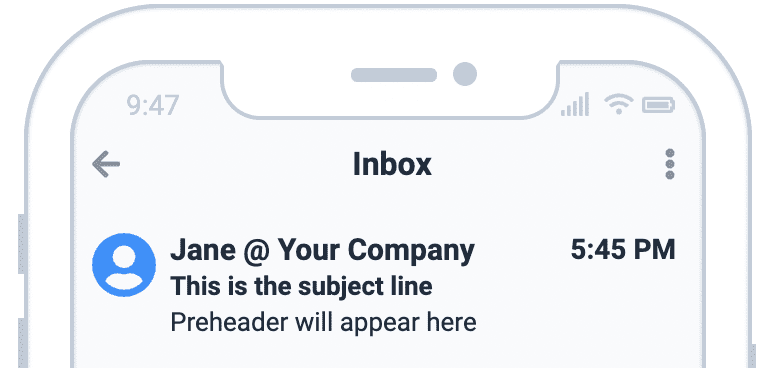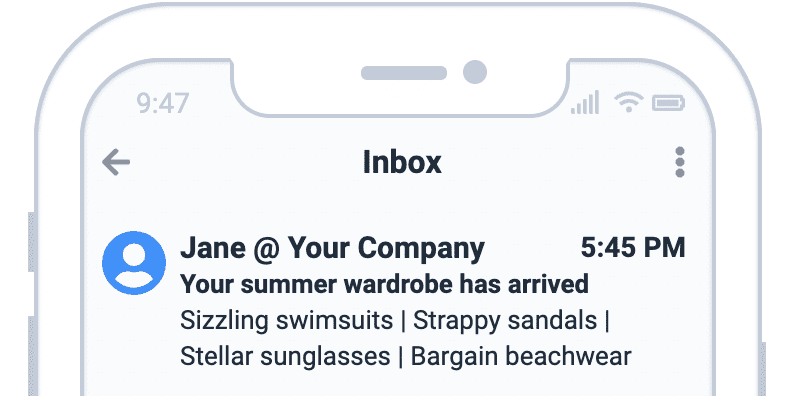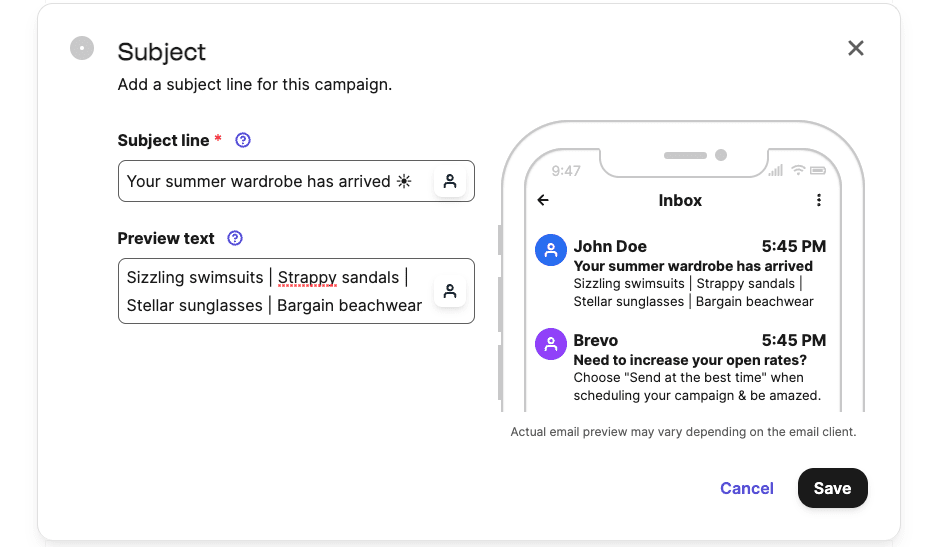
This practical guide will help you understand what an email preheader is, how to write one, and how they can drive results in your email marketing campaigns.
An email preheader, also known as preview text, is one of the first things your subscribers see. This brief snippet is one the most impactful tools in your email marketing arsenal.
More than ever before, preheaders occupy vital real estate in the inbox. Optimize email preheaders to catch your subscribers’ attention and set your campaigns up for success.
This article breaks down preheaders, their benefits, and how to get the most out of them in your email marketing campaigns.
Table of Contents
What is an Email Preheader?
The email preheader is the first line of text that appears beneath the sender and subject line in an inbox. In the body of an email, preheader text appears above the header (as the name suggests).
Preheader is often used interchangeably with “email preview text” or “Johnson box.” In personal emails, the preheader is typically the opening of the message: “Dear Gregory, Thanks for getting in touch…” Most email marketing tools allow you to customize the preheader text for business purposes.
Preheaders are among the most important parts of your email campaign. This is because many people read the preheader before they decide whether or not to click on the email. If the preheader fails to catch the reader’s attention, they may scroll on without opening your campaign.
When used strategically, a well-crafted preheader can help your email stand out in a crowded inbox

Preheader text appears below the sender and subject line in an email client.
How Long Should Email Preheader Text Be?
The ideal length for email preheader text is 40-130 characters.
Bear in mind that emails may appear in each inbox differently. This is because the space allotted for preheader text varies between desktop, mobile, and web email clients (e.g. Gmail, Outlook), as well as the subscriber’s inbox settings.
Sticking to the 40-130 character range will tailor your email preheader to fit a variety of devices and email marketing platforms.
What Are the Benefits of Email Preheaders?
An effective email preheader helps boost email open rates. When written well, this short line of copy helps entice the reader to click on the campaign and read further. Research shows that effective email preheaders can lead to up to 7% higher open rates.
Email preheaders can also improve your email campaign’s engagement. Often, this is because they add further context to the subject line. Readers can see what the email is about at a glance. This will encourage them to engage with your email content.
Preheaders are especially important with the rise of mobile devices. According to a recent study, mobile clients account for 41.6% of email opens. Optimized preheader copy is crucial to catching attention on smaller screens.
Email Preheader Best Practices
To help set your campaigns up for success, we’ve gathered some email preheader best practices. Here’s how to craft preheader text that yields results:
1. Complement the email subject line
Link the preheader text with the subject line. Ideally, the subject line should flow into the preheader text.

It’s better to use the preheader to complement the subject line’s text, rather than complete it. This is because not all email clients display the preheader text, so some subscribers might not see it.
Nonetheless, it’s good practice to always include a preheader. This will keep useless text, like a repeated subject line or unsubscribe link, from occupying vital real estate.
Effective preheaders don’t merely repeat information from the subject line — they provide further context to engage the reader. A great use of preheader text is to summarize the email content. This way, the reader knows what the email is about from the very first line.
2. Keep the preheader concise
Due to character restrictions, the preheader text should be concise. The email preheader should not be so short that it fails to share valuable information with the reader. But if the preheader is too long, it may lose its impact.
The right preheader length is key to grabbing the reader’s attention.
You may want to include additional details in the preheader while keeping the text to the point (for instance, a summary of the campaign’s content). In other cases, it’s beneficial to use very short email preheaders. It all depends on the message you wish to share!
3. Personalize the preheader text
When it comes to the email preheader, a human touch can go a long way in making your campaign stand out.
All you need is to add personalization to the preheader text. This helps draw the reader in. Most email marketing software uses automation to fill in the subscriber’s first name either in the subject line or email preheader.
A personalized preheader is likely to catch the reader’s eye, making your campaign stand out among the many marketing emails that land in their inbox every day.

Personalized preheaders grab the reader’s attention.
4. Engage subscribers from the first line
The most impactful preheaders use a variety of tactics to engage readers.
Here are a couple ways you can use the email preheader to build curiosity from the first line:
- Ask a question to pique interest: “Still need convincing? New study on email marketing ROI!”
- Create a sense of urgency: “Today’s your last day for free shipping! 📦”
In this brief line of copy, you can pack in a range of psychological techniques like fear of missing out (FOMO) to encourage subscribers to open the email and read more.
5. Include a CTA
Another common practice is to include a CTA in the email preheader. Tell subscribers right away what they might want to do after reading the email. Like subject line CTAs, preheader CTAs help grab your reader’s attention and drive conversions.
Preheader CTAS can:
- Entice subscribers to take on a specific action, such as complete a survey or take advantage of a sale.
- Be product-specific: “10% Off Shoes ⏳ Offer Ends Today!”
- Add further impact to ecommerce email marketing campaigns: “Don’t miss this special Fourth of July offer! 🎆”
6. Use emojis to stand out in a crowded inbox
Don’t be afraid to add emojis to the email preheader. This will catch the reader’s eye and break up the many lines of text in an inbox.
Beyond their visual impact, emojis let you add a splash of personality to your message while keeping the preheader brief. Sometimes, they can help reduce the number of characters in your preheader text.
Be sure to use emojis sparingly. Similar to excessive exclamation points and text in all caps, too many emojis can be perceived as spam.
7. Preview the preheader across different formats
Email preheader lengths may vary depending on whether the subscriber is viewing the campaign on desktop or mobile. The character limit for preheader text might also differ according to the email service provider.
It’s good practice to preview the email subject line and preheader before sending out your campaign. This will ensure that the right text appears no matter the format.
Some email marketing tools allow you to see how the preheader will appear on both desktop and mobile and on different email clients such as Gmail, Outlook, and Yahoo.
8. Optimize the preheader for varying character limits
Email clients cut off preheader text at different spots due to varying character limits, and you can’t necessarily choose how the text is cropped.
One way to accommodate for these differences in preheader length is to write in bite-sized chunks. You can separate the chunks using symbols (e.g. | or -), as pictured in the example below.
Inserting blank space after the preheader is another way to catch the reader’s eye while accommodating for varying character limits. This is a common trick called the preview text hack, which uses HTML or Unicode to add blank space after the preheader text.
In many cases, the blank space pushes down any text you don’t want to appear in the preheader. The additional padding also breaks up the inbox’s lines of text, drawing the reader’s eye to your preheader message.

Preheader text written in chunks can be cut off easily by an email client.
9. Use A/B testing
There are several ways to optimize preheaders — A/B test your email preheader text to see what resonates with your subscribers. Try experimenting with the best practices listed above, then track your campaigns’ metrics to see which preheader delivers the best results.
Many email marketing software tools allow you to A/B test both the subject line and preheader, helping you send the most impactful campaigns.
Further reading: How A/B Testing Your Email Subject Line Can Boost Your Open Rates
How to Add a Preheader to Your Email Campaign
Email marketing software makes it easy to customize your campaigns’ preheader text.
Get started with Brevo’s free plan, which lets you send 300 emails per day.
In Brevo, first create an email campaign:
- Once you have a campaign set up, click Add from and fill out the details for the campaign’s sender.
- Add recipients and select the email list of contacts to receive this campaign.
- Click Edit subject. Enter the campaign’s subject line. Below the subject line, you’ll find the field for the preview text. This is another term for preheader.
- Write a preheader in the preview text field.
- Design email content. Build from scratch using Brevo’s Drag & Drop editor, or select from Brevo’s email templates.
- Click Preview and Test in the second tab in the upper right corner. Check how the preheader text will be displayed in different email clients. Edit the preheader text if necessary.

Customize preheaders (a.k.a. Preview text) for your email marketing campaigns
Conclusion: Email Preheaders in Short and Why They Matter
Email preheaders are short and impactful pieces of copy. From the moment you send your campaign, the preheader is one of the first things your subscribers see.
Use preheader text to provide further context to the subject line, summarize the content of your email, and encourage subscribers to read.
By optimizing preheaders, you can drive conversions and improve the overall success of your email marketing campaigns.






